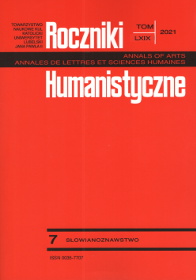Russian and East European Studies after the End of the Cold War: A New Face of the Field
Abstract
The paper deals with the new developments in the field of Russian and East European studies (REES) after the end of the Cold war, with the focus on the U.S. and Great Britain. Along with organizational and structural changes in the field special attention is devoted to new subjects and trends in the study of the region, with Belarus as a case study. Research in this field began in the 90s and has been booming since the 2000s. Researchers are primarily interested in the history of the country, political science, anthropology, and literary studies. The formation of an international community of researchers allows us to conclude that previously “Western” discipline of REES is gaining a global character.
References
Adams, Laura L. «The Crisis of U.S. Funding for Area Studies». NewsNet: News of the Association for Slavic, East European, and Eurasian studies, vol. 53, no. 2, 2013, pp.1-3.
Banerjee, Anindita. We Modern People: Science Fiction and the Making of Russian Modernity. Wesleyan UP, 2012.
Beyond Soviet Studies, edited by Daniel Orlovsky. The Woodrow Wilson Center Press, 1995.
Bolshakova, Olga V. Poverkh bar’yerov: Amerikanskaya rusistika posle kholodnoy voyny. INION, 2013 [Большакова, Ольга В. Поверх барьеров: Американская русистика после холодной войны. ИНИОН, 2013].
Brown, Kate. A Biography of No Place: From Ethnic Borderland to Soviet Heartland. Harvard UP, 2004.
Choldin, Marianna T. «Celebrating ASEEES: Reflections on the 1990s». NewsNet: News of the Association for Slavic, East European, and Eurasian studies, vol. 57, no. 5, 2018, pp. 5-6.
Engerman, David. Know your enemy: The Rise and Fall of America’s Soviet Experts. Oxford UP, 2009.
Gerber, Theodore P. «The State of Russian Studies in the United States: An Assessment by the Association for Slavic, East European, and Eurasian studies (ASEEES). July 2015». Association for Slavic, East European, and Eurasian studies, www.aseees.org/sites/default/files/downloads/FINAL-ASEEES-assessment-report.pdf. Accessed 19 Dec. 2020.
Grachova, Sofiya. Pathologies of Civility: Jews, Health, Race and Citizenship in the Russian Empire and the Bolshevik State, 1830-1930. PhD dissertation. Harvard, ProQuest Dissertations Publishing, 2014.
Graham, Loren R. «Celebrating ASEEES: Reflections on the Inaugural Convention». NewsNet: News of the Association for Slavic, East European, and Eurasian studies, vol. 57, no. 4, 2018, p. 12.
Grant, Bruce. «Celebrating ASEEES: Reflections on the 2010s». NewsNet: News of the Association for Slavic, East European, and Eurasian studies, vol. 57, no. 5, 2018, pp.10-11.
Joyce, Aimee Edith. Border Landscapes: Religion, Space and Movement on the Polish-Belarusian Frontier. PhD dissertation. University of London, Goldsmiths’ College, ProQuest Dissertations Publishing, 2014.
Koerber, Jeffrey P. Born in the Borderlands: Jewish Youth and Their Response to Oppression and Genocide, 1933-1948. PhD dissertation. Clark University, ProQuest Dissertations Publishing, 2015.
Kokobobo, Ani. «What’s in a Name? Are We Slavic, East European, Eurasian, or All of the Above?». NewsNet: News of the Association for Slavic, East European, and Eurasian studies, vol. 60, no. 4, 2020, 17-18.
Men’kovskii, Viacheslav I. «Anglo-amerikanskaia rossica i sovietica na rubezhe XX-XXI vv.» Pracy gistarychnaga fakul’teta: navuk. zb. BDU, 2006, vyp. 6, ss. 243-255 [Меньковский, Вячеслав И. «Англо-американская россика и советика на рубеже ХХ-XXI вв.» Працы гістарычнага факультэта: навук. зб. Мінск: БДУ, 2006, вып.1, cc. 243-255].
Mickiewicz, Ellen. «Celebrating ASEEES: Reflections on the 1980s». NewsNet: News of the Association for Slavic, East European, and Eurasian studies, vol. 57, no. 5, 2018, pp. 1-3.
Novikau, Aliaksandr. Environmental Discourses in Belarus: Issues and Ideologies. PhD dissertation. Northern Arizona University, ProQuest Dissertations Publishing, 2017.
Park, Linda. «2011 Executive Director’s Report». NewsNet: News of the Association for Slavic, East European, and Eurasian studies, vol. 52, no. 1, 2012, pp. 17-18.
Park, Linda. «2019 Executive Director Report». NewsNet: News of the Association for Slavic, East European, and Eurasian studies, vol. 60, no. 1, 2020, pp. 7-10.
Patyk, Lynn Ellen. Written in Blood: Revolutionary Terrorism and Russian Literary Culture, 1861-1881. University of Wisconsin Press, 2017.
Rosenberg, William. «Celebrating ASEEES: Reflections on the 2000s». NewsNet: News of the Association for Slavic, East European, and Eurasian studies, vol. 57, no. 5, 2018, pp. 8-9.
Thurston, Patricia K. «Doctoral Dissertations on Russia, the Soviet Union, Central Asia, and Eastern Europe Accepted by Universities in the United States and Canada, 1999». Slavic Review, vol. 59, no. 4, 2000, pp. 947-958.
Thurston, Patricia K. «Doctoral Dissertations on Russia, the Soviet Union, Central Asia, and Eastern Europe Accepted by Universities in the United States and Canada, 2000». Slavic Review, vol. 60, no. 4, 2001, pp. 897-908.
Thurston, Patricia K. «Doctoral Dissertations on Russia, the Soviet Union, Central Asia, and Eastern Europe Accepted by Universities in the United States and Canada, 2005». Slavic Review, vol. 65, no. 4, 2006, pp. 861-879.
Thurston, Patricia K. «Doctoral Dissertations on Russia, the Soviet Union, Central Asia, and Eastern Europe Accepted by Universities in the United States and Canada, 2013». Slavic review, vol. 73, no. 4, 2014, pp. 970-985.
Walker G. «Doctoral Research in Russian and East European Studies: Trends and Realities from the UTREES Database.» Modern Humanities Research Association, 2016, www.mhra. org.uk/pdf/utrees-paper.pdf. Accessed 12 Dec. 2020.
Copyright (c) 2021 Roczniki Humanistyczne

This work is licensed under a Creative Commons Attribution-NonCommercial-NoDerivatives 4.0 International License.





